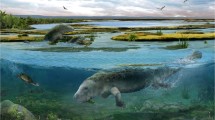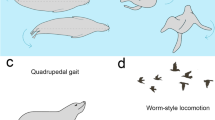Abstract
One of the most marked transformations in the vertebrate transition to land was that of fins to limbs. This transformation involved not only the generation of morphological novelties (digits, sacrum) but also a shift in locomotory dominance from the pectoral to the pelvic appendage1. Despite its importance, the transformation from pelvic fin to hindlimb is the least studied and least well-documented part of this transformation, which is bracketed by the osteolepiform Eusthenopteron and the early tetrapods Ichthyostega and Acanthostega, but is not directly illuminated by any intermediate form. Panderichthys is the closest tetrapod relative currently represented by complete fossils2, but its pelvic fin skeleton has not been described. Here, I present the only known articulated pelvic fin endoskeleton and associated partial pelvis of Panderichthys. The pelvic girdle is even less tetrapod-like than that of the osteolepiform Eusthenopteron3, but the pelvic fin endoskeleton shares derived characteristics with basal tetrapods despite being more primitive than the pectoral fin of Panderichthys4,5. The evolution of tetrapod locomotion appears to have passed through a stage of body-flexion propulsion, in which the pelvic fins played a relatively minor anchoring part, before the emergence of hindlimb-powered propulsion in the interval between Panderichthys and Acanthostega.


Similar content being viewed by others
References
Coates, M. I., Jeffery, J. E. & Ruta, M. Fins to limbs: what the fossils say. Evol. Dev. 4, 390–401 (2002)
Ahlberg, P. E. & Johanson, Z. Osteolepiforms and the ancestry of tetrapods. Nature 395, 792–794 (1998)
Andrews, M. S. & Westoll, S. T. The postcranial skeleton of Eusthenopteron foordi Whiteaves. Trans. R. Soc. Edinb. 68, 207–328 (1970)
Vorobyeva, E. I. The shoulder girdle of Panderichthys rhombolepis (Gross) (Crossopterygii), Upper Devonian, Latvia. Geobios 19, 285–288 (1995)
Vorobyeva, E. I. Morphology of the humerus in the Rhipidistian crossopterygii and the origin of tetrapods. Paleontol. J. 34, 632–641 (2000)
Coates, M. I. The Devonian tetrapod Acanthostega gunnari Jarvik: postcranial anatomy, basal interrelationships and patterns of skeletal evolution. Trans. R. Soc. Edinb. 87, 363–421 (1996)
Jarvik, E. Basic Structure and Evolution of Vertebrates (Academic, London, 1980)
Carroll, R. L., Irwin, J. & Green, D. M. Thermal physiology and the origin of terrestriality in vertebrates. Zool. J. Linn. Soc. 143, 345–358 (2005)
Vorobyeva, E. I. Evolution of the rhipidistia (Crossopterygii) pectoral girdle in the context of the origin of tetrapods. Paleontol. Zh. 3, 3–11 (1998)
Clack, J. A. in Amphibian Biology Vol. 4 Palaeontology: the Evolutionary History of Amphibians (eds Heatwole, H. & Carroll, R. L.) 979–1029 (Surrey Beaty and Sons, Chipping Norton, Australia, 2000)
Vorobyeva, E. I. The role of development and function in formation of tetrapod-like pectoral fins. Zh. Obshch. Biol. 53, 149–158 (1992)
Vorobyeva, E. I. & Kuznetsov, A. in Fossil Fishes as Living Animals (ed. Mark-Kurik, E.) 131–140 (Academy of Sciences of Estonia, Tallinn, 1992)
Schultze, H.-P. & Arsenault, M. The Panderichthyid fish Elpistostege: a close relative of tetrapods? Palaeontology 28, 293–309 (1985)
Vorobyeva, E. I. & Schultze, H.-P. in Origins of the Higher Groups of Tetrapods: Controversy and Consensus (eds Schultze, H.-P. & Trueb, L.) 68–109 (Cornell Univ. Press, Ithaca, 1991)
Acknowledgements
I thank E. Mark-Kurik for collecting and allowing access to the specimen; P. E. Ahlberg for discussions; and Vetenskapsrådet for financial support through a grant to P. E. Ahlberg.
Author information
Authors and Affiliations
Corresponding author
Ethics declarations
Competing interests
Reprints and permissions information is available at npg.nature.com/reprintsandpermissions. The author declares no competing financial interests.
Rights and permissions
About this article
Cite this article
Boisvert, C. The pelvic fin and girdle of Panderichthys and the origin of tetrapod locomotion. Nature 438, 1145–1147 (2005). https://doi.org/10.1038/nature04119
Received:
Accepted:
Issue Date:
DOI: https://doi.org/10.1038/nature04119
- Springer Nature Limited
This article is cited by
-
The pelvic girdle in extant gonorynchiformes (Teleostei: Otomorpha)
Zoomorphology (2024)
-
Paleoenvironments of Late Devonian tetrapods in China
Scientific Reports (2023)
-
A new elpistostegalian from the Late Devonian of the Canadian Arctic
Nature (2022)
-
Elpistostege and the origin of the vertebrate hand
Nature (2020)
-
Expression of meis and hoxa11 in dipnoan and teleost fins provides new insights into the evolution of vertebrate appendages
EvoDevo (2018)





